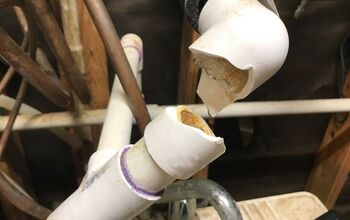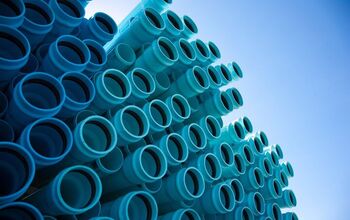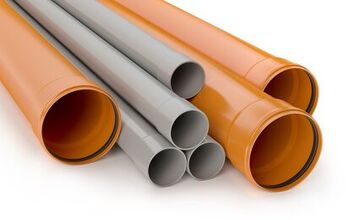How Long Will PVC Pipe Last In The Sun? (Find Out Now!)

Known for its rigidity, strength, durability, reliability, and affordability, PVC has been used as a piping alternative since the 1960s. In average conditions, PVC piping is expected to last 100 years, though it hasn’t been around long enough to be certain.
As with all things, PVC’s lifespan depends on what it’s being used for. We usually think of PVC piping as being used for internal plumbing. But can it be used outdoors? How long will it last in the sun?
If exposed to the sun’s UV rays, PVC is expected to last between 50 and 80 years. Around the one-year mark, PVC starts to discolor. Around two years of exposure, the PVC’s structure begins to break down, making it brittle and breakable. The exposure can be lessened by wrapping the piping in an opaque, heat-resistant material. Painting is the more common solution.
Do You Need a Faucet, Fixture, or Pipe Repair or Replacement?
Get free, zero-commitment quotes from pro contractors near you.

Using PVC Outdoors
While most commonly used indoors, PVC piping is also safe to use outside if you take precautions. PVC is manufactured to resist water and sunlight, and it can withstand temperatures up to 140 degrees. So, even in extreme heat, it won’t melt.
However, PVC pipes should not operate at the high end of their temperature range too often. This is why it’s not recommended for use as a hot water line. Using PVC as a cold water line is acceptable, and this can also be done outdoors. Just be wary that it doesn’t get too cold too often or you’ll have similar issues.
In addition to being sun and weather-resistant, PVC is also impact-resistant, fire retarding, and stands up against micro bacteria.
PVC vs. Copper
While it shouldn’t be used for a hot water line, PVC is overall a better outdoor piping choice than copper. It’s lighter and cheaper and it doesn’t experience as many effects from the elements as copper.
When used indoors, copper tends to last longer than PVC. However, while PVC piping can last 50-80 years in the elements, copper can realistically last around 20 years. Extreme weather is not taken into account for PVC’s lifespan because it’s not considered normal wear and tear.
Sun Exposure Effects
When used outside, white PVC can look inconspicuous and even elegant. But after a year of exposure to the sun, it begins to discolor. After two years, the impact resistance decreases. Let’s take a further look at why this happens.
Discoloration
Discoloration in PVC piping happens because of exposure to UV rays from the sun. Without these ultraviolet rays, PVC could last in the sun forever. The discoloration only affects the first .001” to .002” of the exposed surface.
There’s a process toward discoloration in PVC piping. First, the piping loses its gloss. Then, the surface becomes chalky. And finally, the surface discolors. As discoloration sets in, you’ll notice the PVC goes from yellow to brown to black.
Any part of the pipe not exposed to UV rays will not discolor. And any discoloration will stop progressing if the PVC is taken out of the sun.
The discoloration can slow if the PVC compound has added UV absorbers. Titanium dioxide is the most common additive for the purpose of preventing UV damage in PVC pipes.
Decrease in Impact Resistance
After two years of sun exposure, it’s been found that the impact resistance of PVC piping is decreased. UV rays break down the PVC structure, making it brittle and breakable.
The degree to which the impact resistance is affected is based on the following:
- The length of time the PVC was exposed to the sun
- The climatic conditions endured by the PVC
- The diameter of the pipe
- The wall thickness of the pipe
- The type of PVC compound used
There’s no way to determine how long it will take to notice the effects of impact resistance due to sun exposure. Generally, smaller, thinner pipes will see more exposure damage in a quicker timeframe.
Pipes with thinner walls are referred to as Schedule 40 PVC, whereas pipes with thicker, more durable walls are referred to as Schedule 80.
What Is Not Affected
In the same two-year study, it was determined that some aspects of the PVC pipe weren’t affected at all from sun exposure. The pressure capacity of the PVC remains the same as does the pipe’s stiffness, also known as the external load capacity.
In general, the integrity of the PVC is more or less unaffected by exposure to the sun.
Sun Damage Prevention
With what little damage PVC receives from sun exposure, it’s possible to prevent it from ever starting. To begin, you can get a guarantee on how the PVC was stored. You can also create a barrier between the PVC pipe and the sun.
It’s important to note that if you leave PVC exposed for a little as 3 months and then bury it, the piping will be compromised. Take the following precautions to avoid compromising the structure.
Protective Barrier
The most common way to create a barrier on PVC piping is with paint. This will keep the PVC from discoloring. Lighter paint colors are best because they remain cooler, unlike dark colors which absorb the sun’s heat.
It’s recommended to use water-based paints on PVC because they adhere best. Oil- or solvent-based paints can damage PVC. They will also flake and crack soon after application. In addition, there are special paints that are formulated specifically for PVC.
You can either paint the piping before installation or wait until you notice the onset of discoloration.
In addition to painting the PVC, you can also protect it from sun exposure by wrapping the piping in an opaque material. This will keep the sun from reaching the PVC’s surface. That being said, you need to make sure the material is not a heat conductor.
Protective Storage
Before purchasing your PVC pipes, check with the buyer to determine how they were stored. PVC that was stored indoors or in a covered warehouse should not have seen any sun exposure. This is important to know because you can then determine when to expect discoloration.
If you’re not installing the PVC pipes immediately, you should take storage precautions as well. Below are some preventative measures to take to avoid early sun exposure.
- Before placing the PVC in outdoor storage, remove any plastic wrap from the piping to avoid trapping heat.
- Avoid storing pipes or fittings in buildings with direct sunlight exposure, especially in the summer.
- Avoid storing PVC near equipment that produces heat. Excessive heat build-up may cause distortion in pipes or fittings.
- Pipes and fittings can be covered with a white tarp or burlap for protection. Never use black plastic to cover PVC. It absorbs too much heat that may damage the pipes or fittings.
- Leave bell or spigot ends of pipes open to allow airflow.
Gaskets
PVC pipe gaskets are also manufactured to withstand normal UV exposure. They can be stored the same way as the piping. Unless you notice degradation on the gaskets when you’re ready to install, it’s not necessary to replace them.
Related Questions
We’ve discussed in depth what happens to PVC pipes when exposed to the sun. But perhaps you have more questions. Below are some things other people wondered about regarding PVC pipes and weather exposure.
Is PVC resistant to freezing?Just as PVC has a maximum heat level of 140 degrees, it also has a cold temperature threshold. PVC cannot withstand freezing temperatures. It should not be installed in places that are exposed to temperatures below 32 degrees. At this temperature, the integrity of the PVC begins to compromise. PVC will crack when surrounding temperatures reach 20 degrees. This is something to keep in mind if you were planning to install PVC pipes outside.
Does PVC get brittle with age?It’s not so much the age that causes the PVC to become brittle but rather what the pipe is exposed to. Long exposure to the sun without a barrier causes the PVC to degrade, although this is a relatively slow process. On the other hand, long exposure to extremely cold temperatures will make the PVC brittle enough to crack.
Is electrical PVC UV-resistant?PVC that is rated for electrical conduit is generally UV-resistant. Schedule 40 PVC is not. PVC conduit can be either schedule 40 or Schedule 80.
Why are PVC pipes preferred nowadays?PVC pipes have certain environmental advantages over other materials. In both their manufacturing and transportation, they require less energy. They last a long time with little maintenance or repair requirements and are easily recyclable.
Do You Need a Faucet, Fixture, or Pipe Repair or Replacement?
Get free, zero-commitment quotes from pro contractors near you.

Summing It Up
It’s quite possible to install PVC pipes outdoors without much worry of damage due to sun exposure. After a year, you’ll notice discoloration. This can be prevented by either covering or painting the piping. Over a period of two years, the impact resistance of the PVC pipes begins to decrease. However, there is not a clear way to determine how long before you notice that effect.
If your PVC was responsibly stored in a facility before purchase, you should not notice any effects of sun exposure. You can also take precautions for storing PVC if you have a gap in delivery and installation.
Related Guides

Brigid Levi is a wife, mother, and freelance writer who enjoys a good DIY project and creating beautiful spaces within her home. From cleaning and organization hacks to home decor ideas, she loves helping people in their quest to turn a house into a home. Her hobbies include pretending to be Joanna Gaines while updating her home with her husband and performing in local theater productions.
More by Brigid Levi



























